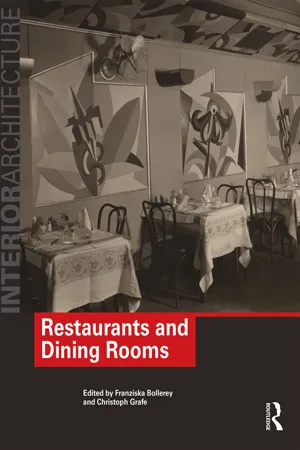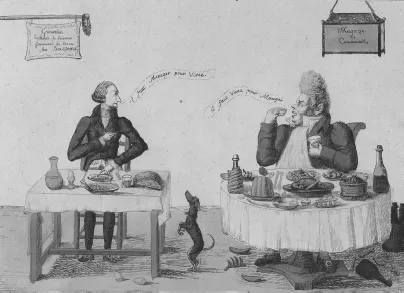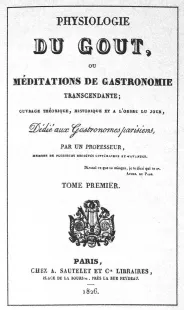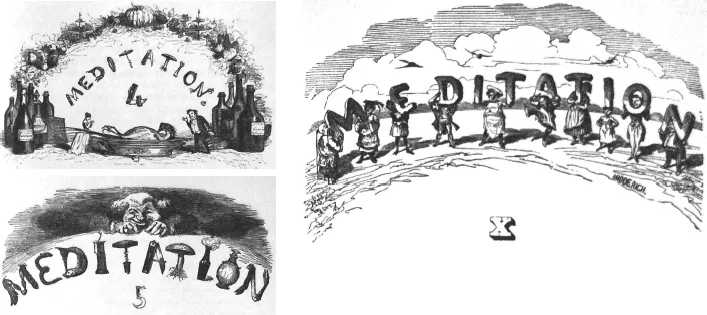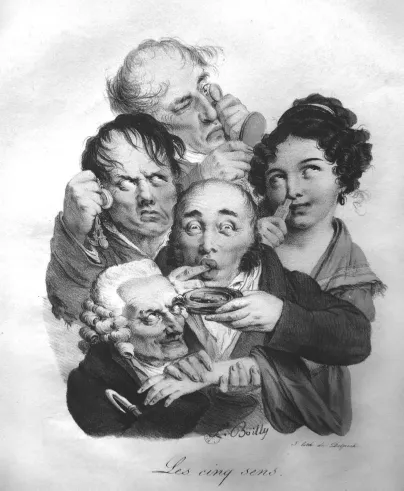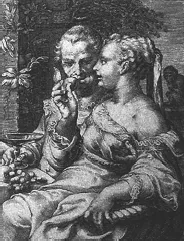![]()
01
The restaurant and the rise of modern ‘cuisine’1
Franziska Bollerey
A thin man gesturing to his plate says, ‘Il faut manger pour vivre’ (you must eat to live) to a fat man, who, with hand raised to mouth, hair fashionably coiffed, replies ‘Il faut vivre pour manger’ (you must live to eat).
In culinary literature, this caricature2 is usually illustrated by a modest rectangular-shaped table, covered with a slightly too-small tablecloth and placed opposite a much grander table, piled high with opulent delicacies and graced by a piece of elegantly draped linen. Each detail is exploited to the maximum: water jug versus champagne and wine bottle, a modest soup and bean stew versus fowl and a generous assortment of vegetables and desserts. Simple and basic tableware on one side, ornate on the other. Here a glass, there a champagne flute. These two diners are the personification of nutrition versus gourmandise. One man sitting under a shop sign promoting a seed, vegetable, and feed business that offers green beans from Soissons, while the other reposes beneath a lantern bearing the inscription ‘magazine comestibles.’ In other words, a delicatessen. This might not actually be a true restaurant scene that pits luxury and fine dining against a simple inn, but it nonetheless addresses the subject of gastronomy (figure 1.1).
Even if the term ‘restaurant’ is defined as a place of culinary pleasure in a sophisticated atmosphere with extravagant personal service and an assortment of elaborate dishes, it should not be limited to this definition – its initial function was food, its preparation and presentation. Social and economic conditions define what is considered edible, how it is to be prepared, as well as the rules involved in its consummation, amount, exorbitance, necessity, and luxury.
The following will mainly address ‘western’ society and its culinary culture. This first section, ‘Inventing food, describing food, consuming food, and displaying food and those who eat it’, discusses the development of the art of cooking, those at the forefront and the modern renowned culinary philosophers and critics such as Jean Anthelme Brillat-Savarin and Alexandre-Balthazar-Laurent Grimod de La Reynière. The next section, ‘ “The birth of the restaurant,” or a name and its consequences,’ deals with the origins of the restaurant as an expression of modern standard of living. The section ‘Quick meals’ is dedicated to fast-food restaurants and street food as a phenomenon of ‘street selling.’ The final section, ‘Nothing new under the sun. Really?,’ attempts to assess new trends in gastronomy regarding their traditional circumstances.
Figure 1.1 ‘To live, you must eat, one lives to eat,’ caricature around 1820.
1 Inventing food, describing food, consuming food, and displaying food and those who eat it
Apologists of the physiology of taste
‘The discovery of a new dish does more for the happiness of mankind than the discovery of a new star,’3 according to Brillat-Savarin.4 He sums up the personification of food and gourmandise described at the beginning of his The Physiology of Taste5 as besoin and désir. Physiology was published in 1826, long before the bourgeoisie began to associate social guilt with their debaucheries. Hence, Brillat-Savarin (figures 1.2a and 1.2b) was able to almost cynically counterpoise appétit de lux with appétit naturelle, which is the pure need to feed oneself (the French word besoin also means need or necessity), typical of less advantaged societies.6 ‘As to the physical effects … eyes grow brighter … as to the moral effects: wits are sharpened.’ And the gourmandise comes at their expense. His book of aphorisms is dedicated to ‘the passionate, defensible, and customary preference for things that please the sense of taste.’ It is the first comprehensive written work on the philosophy of eating and the psychology of gourmets7 and it is still being published today. In thirty essays entitled Meditation (figures 1.3a–1.3c), Brillat-Savarin examines food, gastronomy, nutrition (including obesity and thinness) the kitchen, dinner hosts, appetite, thirst, and digestion. The book is fundamentally a reflection on the senses, as is typical of almost every piece of literature dealing with gastronomy and the culinary arts. ‘The senses (are) the organs by the use of which man communicates with his surroundings.’8 And they are all activated in a restaurant: sight, hearing, smell, taste, touch. Brillat-Savarin writes that
Figure 1.2a Title of Physiologie du goût 1826.
Figure 1.2b Portrait of Jean Anthelme Brillat-Savarin.
Figure 1.3 Title vignettes of Physiologie du goût.
sight, which embraces space, and, through the medium of light, reveals the existence and colour of bodies which surround us; hearing, which through the medium of air receives vibrations set up by sonorous bodies; smell, which enables us to discern the odours which certain bodies exhale; taste, by means of which we approve the sapidity and esculence of things; touch, which determines the consistency and surface of bodies…9 (figure 1.4).
Restaurant guests absorb the interior design of a dining establishment, the arrangement of furniture, the laid tables, and the dishes served. Amidst the general sound of human voices, they can make out individual words spoken by someone at a neighbouring table. The scent of the dishes stimulates their appetite. Taste enables them to discern between the different meals they consume. The sense of touch is perhaps the sense least used in this context, unless of course, one hand caresses another – but the feel of tablecloths, napkins, glasses, flatware, and porcelain is also a sensory experience. The sense of taste experiences a particular elevation in ‘gourmandism.’ The gourmandise is usually depicted as either a voluptuous woman (figures 1.5a and 1.5b) or an overindulgent man (figures 1.6a–1.6c). Philosophical and physiological musings about them are an intrinsic element of all gastronomic literature. Brillat-Savarin, with his own philological flair, introduces not only new gastronomic terms, but also clears up between the voracity, gluttony, and gourmandism.
Figure 1.4 The Five Senses. From Groupes physionomiques, connus sous le nom de grimaces par Boilly, Louis-Léopold Boilly, early nineteenth century.
Figure 1.5a Taste. Jan P. Sanredam after H. Goltzius (The Five Senses), 1595/96.
Figure 1.5b Gourmandise or Taste, Jeremias Falck, 1644/45.
French utopian socialist François Marie Charles Fourier ascribes a new social order to both gourmandism and taste in his psycho-hedonistic draft,
Il faut généraliser la vertu gourmandise et élever le genre humain au raffinement gastronomique, même sur le mets le plus communs.10
In Fourier’s sensualistic worldview, the gourmandise plays a pivotal role in the welfare of all and not just a small minority.
Le bon goût est relégné en civilisation chez quelques adeptes seulement, et ne s’étend jamais à la multitude.11
The second of the famous French culinary authors, Grimod de La Reynière, dedicates his work to these selected few 12...
